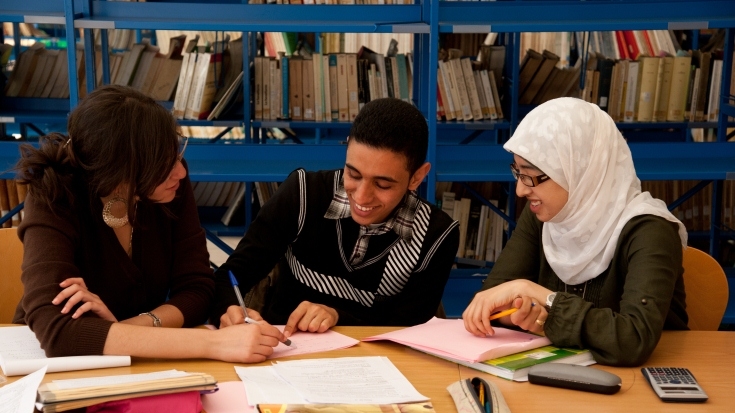In 2003, during times of political and economic uncertainty, with the unemployment rate as high as 29 percent in the West Bank and 38 percent in Gaza, the private sector had very low capacity to absorb new and increasingly less skilled workers to the labor market. Per capita real Gross Domestic Product (GDP) was lower than 38% in the Palestinian Territories – as compared to when? Furthermore, the tertiary education system in West Bank and Gaza faced increasing demand for jobs from secondary education graduates; there was pressure to maintain the quality and relevance of academic programs, and sharp competition for a share of public funds. Families had to bear the burden of increasing student fees since public support to tertiary education was at a low l5.6%.
Solution
The West Bank and Gaza Tertiary Education Project was designed to improve the policy-making environment for tertiary education and increase the efficiency of tertiary education institutions. It aimed at creating incentives and providing the basis for better efficiency, quality and relevance of tertiary education institutions, in order to meet the socioeconomic needs of the Palestinian Territories population. The project drew from lessons gained through preparation and implementation of similar GWBTF financed higher education projects in other countries where the introduction of merit-based allocation of funds for universities and colleges to other project components, particularly increasing funding for the Quality Improvement Facilities (QIF) grant and related consulting services, has proved beneficial. Project identification and preparation also benefited from a World Bank report entitled New Challenges for Tertiary Education (2002) and Lifelong Learning in the Global Knowledge Economy (2003). Consultations with stakeholders contributed to exploring and building consensus around various policy options as well as to explaining the implications of each potential policy reform.
Results
The Tertiary Education Project helped to achieve the following key results during the period 2005-2012:
- At project closing in December 2012, a National Higher Education Strategy was prepared and is awaiting official adoption
- All universities have conducted an institutional self-assessment, and used it to produce or revise their strategic plans
- 71% of colleges have conducted an institutional self-assessment exercise and produced their reports and have produced or revised their strategic plans based on the self-assessment.
- All universities benefited from Quality Improvement Facilities (QIF) grants
- 50% of colleges benefited from QIF grants
- Entry of students into priority areas increased from 32% in 2004-05 to 42% in 2012 – exceeding 40% target.
- New entrants into colleges increased from 19% in 2004-05 to 27.4% in in 2012 – slightly exceeding 27% target.
The overall outcomes of the project are an increased capacity of the Ministry of Education and Higher Education (MOEHE) to reliably collect, manage, and present data. It is now also better positioned to provide future decision making support. Additionally, Tertiary Education Institutions (TEI) are now better capable of assessing and responding to student and labor market demands as well as developing more relevant and efficient academic programs to meet the social and economic needs of the Palestinian people, particularly female university students in Gaza. Furthermore, the project has helped the Ministry of Higher Education to foster innovative and labor market relevant academic plans and practices.
Bank Group Contribution
The project profited from a strong ownership and commitment by the Palestinian Authority, demonstrated by the adoption of many of the policy reforms proposed in the 2002 Higher Education Strategy, which aimed at making the system more effective, more accessible to students from low income households, more relevant to Palestinian economic and development needs, and financially sustainable. While the United Nations Educational, Scientific and Cultural Organization (UNESCO) took over the expansion of the student aid program component, the other components of the project were carried out with a total funding of US$21.6 million in Trust Fund grants, where IDA initially contributed an amount of US$10 million—later complemented by additional financing of US$5 million—and the European Commission provided financing of US$6.6 million.
Partners
The project benefited from collaboration between the World Bank Group and partners such as UNESCO and the European Commission. The European Commission co-financed consultant services and training to strengthen the capacity and efficiency of TEIs and to support the QIFs. Additionally, the high level of collaboration and participation from all local stakeholders set the ground for the overall success of the project.
Moving Forward
The activities funded under the project’s QIFs contributed to more efficient ties between TEIs and the labor market. The educational programs funded under the project have significantly increased employment opportunities as in the case of health professions such as midwifery and anesthesia to name a few. Furthermore, the project positively impacted the dialogue between TEIs and the labor market, and TEIs are now making their educational programs more relevant to provide the labor market with the needed skills. TEIs are now also more effective and efficient at sharing information with the labor market through career days and fairs where students can interact with potential employers.
Beneficiaries
Students were the main beneficiaries of the project, together with the universities and colleges and other regulatory agencies in higher education. The Ministry of Education and Higher Education also benefited from the project. It was noted that the “QIF has invested its resources in educational programs that significantly increased employment opportunities. For example, in health professions such as midwifery and anesthesia, there is immediate demand and close to 100% employability for the graduates after studying for two years. The same is the case for pharmacists, science lab technicians, and specialists in autotronics in Gaza… R&D relevant projects have not only had a short-term impact in terms of employability, but have the potential to be the backbone to build a more productive and competitive economy [and] QIF has provided some basic building blocks in that direction.”
